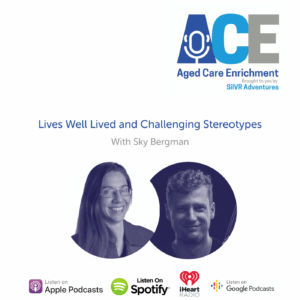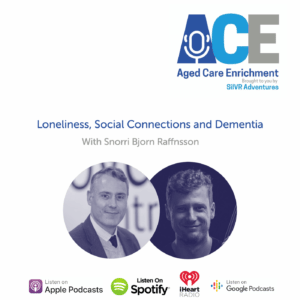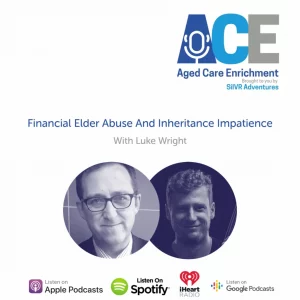Gerontologist Carrie Peterson has been based in Denmark for the last 10 years, where she has worked as a consultant and advisor to organisations such as the World Health Organisation, and Aging 2.0. As part of her PhD Carrie investigated the use and engagement levels of smart home technology in a range of european countries with varying cultural backgrounds, including Denmark, Greece, Northern Ireland and Finland.
And it’s the regional differences between European countries, and between Europe and the rest of the world that we focus on in this interview. It’s fascinating to hear Carrie’s experiences across multiple countries and gives us great insight into how our aged care systems and policies could look different.
Transcript
Ash de Neef: Carrie, thank you so much for joining us on the podcast today.
Carrie Peterson: Thank you for having me. I’m happy to be here.
Ash de Neef: Can we start with a little bit about your story and your experiences?
Carrie Peterson: So starting way back. I grew up in a small village in South Dakota in the United States, and there, we had a nursing home where my grandparents and my mother worked. So I spent a lot of my youth in the nursing home. And this is obviously had a tremendous impact on the rest of my life and my career.
I went on to get my professional degree in applied gerontology, which is ageing studies. And there I focused on dementia and counseling psychology. I thought I was going to get more into end of life care and hospice bereavement counseling. But at the same time, I also worked for both an Alzheimer’s association daycare center and as well as private families.
And so I absolutely knew that I wanted to have a career continuing working with people with dementia. So shortly after finishing my master’s degree, I moved to Denmark and here was really exciting and challenging to be a foreigner in another country. And since I’d recently finished my degree, I was quite eager to work in the area of dementia, but this was really nearly impossible until I learned the Danish language and the healthcare system of Denmark.
So in the meantime, I started thinking about what the next wave of dementia care, what that’s going to look like, what it’s going to be. So I can keep my skills relevant for the future. And that’s how I decided to do my PhD on quality of life and smart home technologies and dementia care. And again, this was a tremendously rewarding experience coming from a psychology and ageing background.
And now here I am sitting in engineering, science and medicine department. So it was a really exciting time. A mix of skill sets and mix of education was really inspiring for me. So since then I’ve been working with companies and startups. I’ve worked with national governments and local authorities, NGOs, IGOs, private individuals, research institutions, and research projects.
Ash de Neef: Fantastic. And you mentioned smart homes, that was a subject of your research. What is a smart home and how can that be effectively used in aged care?
Carrie Peterson: What we used in my research project was plug and play technologies that are already available on the market because technology advances so fast.
So it was felt that rather than inventing a whole new type of system or a whole new thing, let’s take what’s already available and see how we can use that to create a smart home environment. So we use things like floor sensors to detect if there had been falls. Sensors on windows and doors, which can tell if they’ve been opened in the middle of the night. Which in Scandinavia could be quite a dangerous thing, if people wander out in the middle of winter, in the middle of night without proper clothing on.
We used cooker monitors, which could either, depending on the level of need, they could either monitor how long the cooker was used or they could automatically shut off if a person was safe to only boil water or only use the oven for 30 minutes, for example.
And then we also had some safety measures and communication measures in the homes. We had a touchscreen computer where the person with dementia could just press a button and then come in contact with their care partners. And as well the care team could coordinate with each other over an online platform.
So there’s a couple of different levels. Some of it was focused on direct safety in the home for the person with dementia. And the other things were focused on high level coordination of care in the municipality.
Ash de Neef: So in the research that you were doing was it that these devices or these technologies were being implemented into a home or people were being brought into an environment that were full of these technologies?
Carrie Peterson: The were being implemented in the home and we used four European countries to test this. So we use Northern Ireland, Denmark, Greece, and Finland. So we selected people and we had both control group and test group. So it was also important that they were living in their own home. So we didn’t disrupt the quality of care and their quality of life as it was before.
So that we already had a baseline measurement there. We created a smart home environment for them.
Ash de Neef: And did you notice anything different across the four countries that you were testing?
Carrie Peterson: There were quite a few cultural differences, and that was also interesting and exciting. Having grown up in the US and primarily working with English speaking people who also grew up in the US, this was definitely a new experience.
So we found some of the things like the participants in Greece were a little more emotional about describing how their quality of life was. So if they felt it improved, you knew that they felt it improve. Their face lit up, they answered it’s going great. Everything’s excellent.
Whereas we found maybe people in Denmark who are a little more, calm across the board. If they felt the quality of life improved it would be “yeah good.” And that was really exciting for them. So some of those cultural things that we had to learn and interpret, and then figure out how we can actually get closer to quantifying that in research. Because it’s hard to just, come and say, ” well this is my opinion and therefore it’s official research.”
So it was a new little challenge. We weren’t expecting.
Ash de Neef: Now with these technologies, this was of course a controlled research environment. But were you seeing, or are you seeing now in, you said you’re based in Denmark. But are you seeing in Denmark or around the region, any widespread adoption of these technologies?
Carrie Peterson: This project that I’m talking about, my PhD, that started about 10 years ago. So I finished that about six years ago. So thankfully I’ve seen the field develop and the research that I’ve done being integrated a bit more since then. So what we’re seeing is living labs are created and there’s a living lab network here in Europe, at least. And Some of those are using smart home technologies that people can go in and test and model them there.
Another thing is these nursing homes of the future are starting to pop up and I’ve visited a few here in Denmark as well, where they’re integrating smart home technologies. A lot of the safety and communication things, which are really important in dementia care, and as you get more into frail aged care services. So floor sensors, emergency calls, planning, and coordination, that type of stuff.
Rather than the, maybe what mainstream would think of as smart home technology. The lights automatically turning on, or the refrigerator automatically ordering food. We didn’t get into those types of things. And I don’t see those really developed for ageing adults yet, although there’s a lot of potential for them there.
Ash de Neef: And with these nursing homes of the future, the use of those technologies sounds like it will in turn free up staff attention, so they could focus on other concerns. Whether that’s the emotional or whatever other needs that the residents might have other than just keeping an eye on things and making sure they’re okay.
Carrie Peterson: Exactly. And that’s one of the goals of these technologies is that the intention isn’t to replace personal hands-on care, the intention is to support it so that the people giving the personal hands-on care can do what they do best. Which is connect with people and make them feel safe and comfortable.
So the technologies can take over a lot of the automated tasks and especially around paperwork that frontline healthcare workers are continually having to deal with increased paperwork and documentation. So these smart home or smart technologies can automate quite a bit of that for them.
Ash de Neef: What are some of the key differences in the approach to the healthcare system or ageing in Denmark that you’ve been working through these last years?
Carrie Peterson: Yeah. Okay. That’s quite exciting as well. And I should maybe give a little bit of a disclaimer that this is a lot based on my personal experience of living here and using the health system in Denmark, because my work didn’t focus just on Denmark. It focused on Europe in general, and particularly on countries that needed more support.
So Denmark or the Scandinavian countries actually have quite advanced healthcare systems that they weren’t requesting as much support for their digital health systems. But in Denmark, first of all, it’s a much smaller country than the US. So I was happy to find that policy changes are implemented much more quickly here.
So in the field of dementia, which I’ve kept up with here in Denmark, of course, if there’s one year and they decide to do a policy change, and we’re now going to focus on this and this within one or two years, it’s actually rolled out and frontline healthcare workers are trained. And policies are implemented and funding is in place and boom, we’re off to go.
Whereas I felt like in the US it is a much larger country and it’s a little harder to get these initiatives going and get all the things in place. As far as policy governance, framework funding, the actual people who are trained and competent to carry out the services. So that was one big difference I noticed is that things tend to happen faster here.
Denmark is a society that has a high level of trust as well. So as far as digital health services, people are a little more willing to start them because there is a high level of trust in the government and things are more transparent here than I found in the US at least. So people could easily see who was using my information for what purposes, what rights do I have to change or adjust this information and then giving consent to share it or to collect it.
Whereas in the US, I don’t think people are quite as trusting about those things and the information is not as clear. And part of that could be it’s so decentralised in the US as well. So each individual state can come up with their own protocols and practices.
Ash de Neef: Is it the case in Denmark that the public health sector is larger than the private health sector or what’s the divide there like?
Carrie Peterson: I would say so. The public health sector is quite supported here and that’s the main health sector. There’s private health sector here as well. And you can get private health insurance often through your job, through your company that you work for, but it’s not mandatory. I’ve never had private health insurance in 15 years in Denmark and I have survived just fine.
I feel like it’s actually a really good quality care and timely care that I’ve got here anytime I’ve needed it.
Ash de Neef: Have you noticed anything culturally in Denmark or in Scandinavia that’s different to the US and how people relate to ageing or relate to elderly?
Carrie Peterson: One thing that surprised me about moving to Denmark and I found it was actually quite common in Scandinavia, in general, in Northwestern Europe, is that the nuclear family is not as big of a priority as it was in the U S where I grew up.
And I think a large part of that is because the public health system and social system is so strong here in Denmark. So there isn’t a need for families to take in aged adults and try and find a way to make that work. So there’s less pressure on this sandwich generation. Who’s caring for ageing parents, as well as their own children. There’s less pressure on them financially and socially and as carers. So that was one big difference.
I noticed another one is that here in Denmark, older adults they have so much life and energy in them. So I will see, a 70 year old woman with bright red bangs dyed walking down the street. Whereas in the US that would be, quite a shock. Maybe I would see that in California, in New York, but not in the small village of South Dakota. Where I grew up, there was no women over 70 with nose piercings or tattoos or dreadlocks or things like that.
So that was actually quite nice to see here in Denmark is that it seemed that there was a little bit less stigma on what an older person should look like and how they should behave. And that’s quite freeing. I find, yeah, that was one thing I really appreciated about moving to Denmark.
Ash de Neef: What changes would you like to see within aged care or dementia care in the coming years?
Carrie Peterson: One of the things that I’m most excited about is that we’re moving away from a curative model to a care model in health. So we’re giving more emphasis to what’s important to individuals in their lives and what can be supported through care. Rather than simply meeting requirements for basic care standards.
And this helps to bring value to this portion of society. When we actually engage them with how do you want to live? What do you want? And this baby boomer generation will continue to be a powerful driver of change in aged care.
So particular to dementia care and support we know that the fix it model doesn’t work. Dementia requires ongoing education, support and care.
That also changes with the levels of need as they change. And actually not only for dementia care, but many health conditions are best treated when you have longer term care based models, which adjust and continue.
I also really enjoy the increased attention is being paid to palliative and end of life care, which is kind of how I got my start into the field of dementia. And these have traditionally been overlooked in the curative health model because you can’t cure someone who’s actively dying, but their needs are actually incredibly important. So this is great that they’re actually being more integrated through this care model.
So also talking about this care model. I like that there are care communities being developed. These are communities that move beyond disease or condition specific needs, and they create spaces where people of all abilities and all health levels can participate. So they create an area where there’s life of independence for the people living there and the taboo and stigma of disease and disability are removed.
And they also focus on counteracting isolation and loneliness. So these care communities, they move beyond dementia friendly to be inclusive, and also to support the dignity of the person, rather than giving them a label of – you know, move into a dementia friendly area, which sounds very nice.
But then you move into somewhere that has the stigma of I’m a person with dementia. So these care communities, I like that they’re moving beyond any health state and kind of becoming open, more caring communities in general. So what we find too, is that what’s good for a person with dementia is actually good for all people in society.
So having these care communities popping up, we also find that people with brain injuries are moving there. People with autism, people who don’t have any specific health needs, but like to be in a more open, independent space like that. So it’s catching on and that’s quite exciting to see as well.
Ash de Neef: What do these care communities look like?
Carrie Peterson: So there’s one that’s being worked on here in Olin Suh in Denmark, and this community they’re calling themselves the city of life, but it’s along this care community type of model, which is also a new care model, which is great to see those developing as well at aged care.
So this community, they are largely focusing on dementia. So they’re creating housing for different levels of need for 200 people with dementia and then the whole community. I think there’ll be around 500 people living there. So it’s only proportion of the people living there that will have dementia.
And they’re setting up hairdressers and shopping centers and theaters and pubs and restaurants and all the things that you would want in a little tiny community that you could walk about and have it be safe. There’s only one entrance and exit where there are security staff on. So they notice if someone is leaving the property unattended, and they’ll also know how to handle that situation because there’ll be primed on how to address someone with dementia, if they’re walking away or being combative.
And then they’re also creating a space for the increased levels of care. So a person could move into this community and live independently with dementia, they can move in with their entire family. If it’s a younger person with dementia who has children, or they can move in with their spouse and both them and their spouse could get increased aged care as needed right there in the community. In a very brief nutshell that’s what this care community is starting to look like.
Ash de Neef: You said that only a number of the people living there would potentially have dementia. Is that to say that there will be people who aren’t connected to dementia in anyway? So people who don’t have family members, just normal civilians living amongst the population as well?
Carrie Peterson: Yeah and I think that’s really exciting because it helps normalise dementia. So again, to reduce the taboo and stigma of it, so it helps to normalise it that people actually do have this. They can still contribute and participate in society. It’s not that they should be shut away in nursing homes.
And here’s an example of how we can do this. So I think it’s absolutely great that they’re mixing the type of people who are allowed to move into this care community.
Ash de Neef: Yeah, I think internationally, the reputation of Denmark is a country that – Scandinavia in general are countries that – are willing to look at the constructs of society and re-examine how they might be used.
Are there other examples within dementia care or aged care that you can think of that are examples of this?
Carrie Peterson: As I mentioned briefly before there’s new care models coming up, and these are integrated co-housing or remote services being available. That’s a new model of care.
There’s another one called share giving, which I think is quite exciting. It came about with people already living in their own communities and realising that,” okay, the couple down the street, they’re having some mobility problems after hip surgery. So let’s get together and, make a team and I’ll bring dinner this night, you bring dinner the next night, you help them clean the house, whatever, until they get back on their feet.”
So this idea of share giving is actually being spread out as well within small pockets of communities. So I think the people themselves, especially active ageing adults who are younger, maybe in the early sixties who are moving into shared type living, maybe after a divorce or maybe after a spouse has died. So they don’t want to live alone.
They want to live with someone else. They’re still really active. They don’t need to be living in a nursing home or a retirement community. You know, grassroots built up some of these new care models that are now being spread out and studied.
Ash de Neef: Did that just grow up organically?
Or is that something that’s been like, trialed like,” Hey, can you keep an eye on these people?” How does that work?
Carrie Peterson: I think mostly it came about organically. An, from my youth growing up, we just viewed this as being a neighbour. If someone’s spouse died, everyone else in town, it was a really small village, but everyone else in town rallied and would bring over food or help with childcare or whatever needed to be done.
But now formalising it. And also researching it gives it more weight so that it actually, we can study, how is this best to happen? What are the effects and what needs to be in place for this to be the most successful model we can try right now. So as we study these things, then it’s a little bit easier to spread it out because we have a clear path forward.
Ash de Neef: These are some exciting ideas that you’re seeing come up. Do you think there are some challenges that need to be overcome to, to see these ideas more widely used?
Carrie Peterson: So one is continued education and literacy on health to reduce taboos and stigmas and especially around dementia, which still has quite a bit of stigma around the world.
So this education and literacy, it’s not just for the frontline health workers or institutional staff. It’s also for people in the community so that we can better recognise if someone on our street might have symptoms of dementia and how we can respond appropriately. You also hear about these dementia friendly initiatives with more businesses and governments trying to make their services and their staff more attuned to servicing people with dementia.
But if we take that to the the local model, the community model, they still need quite a bit of education and health literacy around this as well. And I think that’s going to be a continued challenge.
Ash de Neef: Carrie, how do you think care facilities can be innovators in dementia care.
Carrie Peterson: So for many people who have experience working with dementia, they know that no two people with dementia are the same. They don’t have the exact same needs and there’s no one size fits all solution that’ll work for everyone.
So one needs to have a supply of creativity to adjust to the symptoms of dementia over a day, and then over longer periods of time. So sometimes what works one day is not going to work the next day. And it’s this that makes people with dementia and around them some really great innovators. So just having people with dementia in your facility, you’re already starting to think of new creative ways that are going to work to bring value to this person’s life. And that really is the first step in innovation.
So innovation just refers to something new or change made to an existing product idea or field, but it’s not just about products or technologies. It’s also innovation to how things are done to management and to organisations.
So once we have this creativity, which is the ability to generate new and novel ideas. This is the seed of innovation, but unless it’s applied and scaled, it’s still just an idea. So when we look at innovation, it should be in the context of implementing ideas that are new and useful. It shifts an organisation’s focus to acting on good ideas that add value. And importantly, we can benefit from treating innovation, just like any other business disciplines.
So it’s a set of tools that are designed to accomplish specific objectives. And just as we don’t rely on a single marketing tactic or single source of financing for an organisation, we need to build up a portfolio of innovation strategies to continue to address aged care needs.
Ash de Neef: I think you’ve raised a really nice point there about some things that work one day and not necessarily going to work the next day.
And it’s very easy for me to have these conversations with people and nod along and say, yes, the person centered approach is the right way, and we should always be paying attention to what the person has specified. But the reality is that in some situations that’s going to change from day to day and it needs to be an ongoing process where the person is always being consulted and their wishes are always held as the central focus for the action or the care plan.
Carrie Peterson: I would tend to agree with that. Yes. But one of the valuable lessons that I’ve learned in working with inter-governmental organisations is that while they want their services also to focus on the person and be person centered, you still have the whole chain of the organisation. Where you have to come up with the governance models and the policies.
So if you’re innovating also the organisation, the process of how things are done, that might be more about creating the culture of innovation and a culture of change. So that doesn’t necessarily trickle down to direct effects onto a person as far as person centered care, at least not immediately, but it’s still moving towards that.
So keeping that purpose in mind that we’re trying to support person centered care when we use any technology or any other innovation, we can keep that in mind so that it continues to have meaning and is useful.
Ash de Neef: Yeah. You mentioned something there that I haven’t heard much of in relation to the care industry, which is what’s the culture around a business.
And what’s the culture around an industry that seems to be often used in management. But I haven’t really heard that much in the, not in the way that how a staff manifesting the culture of a specific care provider. And what can care providers do to create an environment which supports staff to better help their residents.
Carrie Peterson: So I think one of the important things is to keep the innovation cycle and feedback loop open. So the frontline health workers are usually the first ones to notice if a new way of doing things or new product or service is actually working for their patients or not. And having this innovative culture and an organisation actively encourages these health workers to provide feedback and then actually uses that feedback in the loop to continue improving.
So it’s not enough just to ask nurses and doctors to provide feedback, but they also need to see that’s valuable for the organisation and that it’s used to improve things. So that innovation cycle and feedback loop, those are really important. I think to changing this culture of innovation, especially in aged care industries.
Ash de Neef: If these are things that contribute to innovation. What do you think leadership within dementia care and aged care looks like?
Carrie Peterson: So I think that leading by example, and taking personal accountability for actions are some of the first things that good leaders can do. Whether that’s a nurse, whether that’s a janitor or whether that’s the CEO and good leaders are visionaries who are not only willing to change how things are done.
But they can clearly communicate this realistic vision and then inspire others to collaborate on reaching this potential. So from an organisational point of view, it’s important to provide incentives for these individuals to show leadership and also important to provide a clear path for them to achieve these institutional goals so that their leadership is directed towards something.
But it’s also important that a whole culture is fostered where people are empowered, supported, included. And this is from the workers to the customers. And this also means understanding the rights and recognising the potential. And part of that is keeping the values of personhood central. And this also advocates the advancement of human rights.
Once you get into it, at least how I see it is this is, a nice, happy leadership cycle where people can take initiative and be responsible, take their accountability, and also be visionaries to really make change within their own organisation.
Ash de Neef: Do you see that in the professionals or the industries or the governments that you work with, that there is a cycle of leadership and a cycle of innovation.
Carrie Peterson: I see it more active in small and medium companies or in startups where, especially the feedback loop and innovation feedback loop is really important to startups where they’re continually improving their service. It seems like the larger an organisation gets the longer it takes to turn the ship around.
So we start to see this happening. And quite a few countries have also committed to being more transparent, showing more integrity, willingness to build partnerships, things like that. So these are steps in the right direction, but I think for large organisations or for governments as a whole, it’s a bit more work to get them to fully get on board with the way that startups and small companies can actively change.
Ash de Neef: Is there any integration between, for example, the Danish government and startups in aged care and dementia care?
Carrie Peterson: Yeah. So the governments helps support. They have a certain pools here. So pools of money where, let’s say one year they really want to focus on nutritional needs in dementia. So then they have this pool of money and both programs as well as startups or other companies can come in and apply for this funding towards a project that addresses this particular topic.
And the government here in Denmark will change that every couple of years. So one year it may be focused on nutrition the next year. It might be focused on loneliness the next year, it might be focused on, men’s rights or something completely different. So it also gives an opportunity that it’s not just one focus. That there’s several different branches and opportunities for different development to take place.
And when these happen, then of course the government’s interested in the results of that and how it can be scaled up if it is successful. So I think they’re quite active in communicating with smaller companies and startups about how they can continue to improve here in Denmark in general.
Ash de Neef: This is the case that the Danish government has taken a look at what areas need addressing and made a list and thought, “okay, so this year we’re going to focus on this thing and we really want to stimulate growth and ideas within this part of care.”
Is that right?
Carrie Peterson: Yeah. So they’ll, when they come up with their strategies. So for example, dementia strategy or a healthy ageing strategy, they’ll have certain priorities. And then there are key performance indicators that they want to hit in three years or five years. So Denmark is actually quite structured about setting these things up.
But I feel that it helps society function a little quicker because everything’s quite clear and transparent of “this is what we’re focusing on. This is the money we have available. This is what’s going to be focused on next year, and this is the year after.” So people can already start to plan,” okay, three years from now, we’re going to be getting into this area. What can we do to already start to break into that field? “
Ash de Neef: We’re almost out of time today. Carrie, is there anything else you’d like to talk about before we wrap up?
Carrie Peterson: So I think that ageism is perhaps the only ism, which is still socially acceptable. And it’s unfortunate that we still find this in the aged care community. So increasing our intergenerational activities and tapping into the resources the ageing adults can already provide are another way to help remove this ageism in society as well.
Ash de Neef: Carrie, thank you so much for joining us today. Thanks for your time.
Carrie Peterson: Thanks for having me, Ash.






